I was able to borrow a USB device that copies camera pictures to my laptop (woohoo!), so now I can add pictures to blog entries while here in Gautemala. Good thing too, because pictures are important for this story.
The contrasts below are not poor vs. wealthy, but between miserable vs hopeful. Guatamala City is very hilly, and there are a number of large ravines where people with no where else to go simply start putting up corrugated tin houses. If they are not driven out, they eventually replace the corrugated tin with cinder block.
This set below was taken from the Guatemala City town cemetery, which is right next to the town dump. The town dump is in the same ravine as the picture above, but further downstream. As you can see, the trash is dumped into the ravine, and some dirt is put on top, but most of it is exposed.
If you look more closely, you can see people waiting for the garbage trucks to empty out, so they can pick out stuff they can use: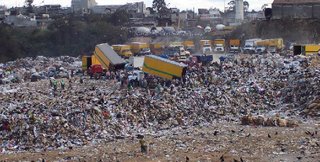 We saw the movie "Romero" the other night, and one of the scenes had someone being dumped in a trash pit exactly like this. At the time I thought it was just Hollywood creative license, but as I stood there, it did cross my mind that it would be an ideal place to dump an unwanted body.
We saw the movie "Romero" the other night, and one of the scenes had someone being dumped in a trash pit exactly like this. At the time I thought it was just Hollywood creative license, but as I stood there, it did cross my mind that it would be an ideal place to dump an unwanted body.
The eerie part was the turkey buzzards, which are the black specks in the sky in the pictures. It felt like a scene out of some Goth Hitchcockian thriller, except with young Mennonites standing around, taking pictures. They filled the sky and also perched ominously on gravestone crosses (the buzzards that is, not the Mennonites, who, as I already said, were standing around taking pictures).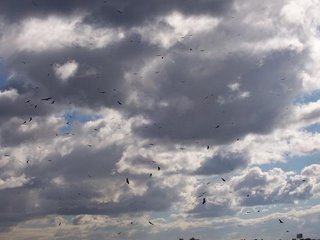
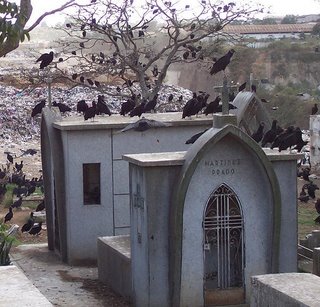
If you haven’t guessed by now, the pictures above represent the “miserable” side. For the hopeful contrast, we visited UPAVIM (United To Live Better), which is a woman’s cooperative in one of the poor barrios. Here’s a picture of the neighborhood:
The UPAVIM building is below. It was started in 1990 by women. Many of the women in the neighborhood are single or suffer from domestice violence and when they go to work, their kids have to be shut in their houses all day, or they just run around in the streets. Other problems in the neighborhood are typical for areas of extreme poverty: gang violence, alcoholism, illiteracy, lack of health services, and lack of funds to send kids to public school (where families usually don't have enough money to pay for books and fees, even for public school).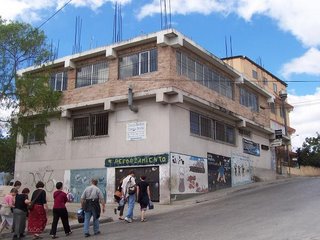
UPAVIM started as a “healthy babies” program, but they started making handicrafts for fair trade organizations like Ten Thousand Villages, and this allowed them to start providing other services for the community around them. It is amazing what they are able to accomplish by selling handicrafts which are fairly traded:
- Pharmacy and clinic for health care
- Nursery school for babies
- Montesorri school for elementary kids
- Scholarships for books and fees for public schools
- Tutoring for neighborhood kids
- Healthy babies program, which monitor babies for health problems

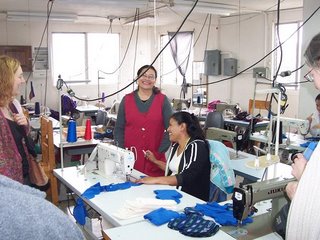
I’ve always been supportive of Ten Thousand Villages, but have also become a little more ambivalent about it over the years, because at its root, it still relies on consumerism to make people’s lives better. There has to be a more sustainable way to help others than to "shop for justice." Nonetheless, seeing purchases make a real difference in the lives of desperately poor people underscores that even though it isn’t perfect, it seems to be effective.
So, for those of you who like clear, unambiguous morals at the end of your stories, and don't yet feel like this story has sufficiently hit you over the head with a hammer: The moral of this story is to buy all your stuff at Ten Thousand Villages, or poor people will be forced to eat garbage.
A corollary moral might be: Everytime you drink a cup of coffee that isn't part of the Fair Trade program, somewhere in the world a puppy will die.
Other morals will be left as an exercise to the reader.

3 comments:
do they sell perishables at 10,000 villages? otherwise, i'm forced to kill puppies.
thanks for your posts on guat.
Actually, they do sell fair trade coffee and fair trade chocolate there. At least they do in the Champaign store. Hopefully your local store sells them too.
Remember that if they run out of puppies, they start using kittens...
"Everytime you drink a cup of coffee that isn't part of the Fair Trade program, somewhere in the world a puppy will die. . . "
and be thrown on a Guatemalan trash heap for the turkey buzzards.
(Never underestimate the power of shock value to change consumers' habits.)
ramhist
Post a Comment